Natural flood management (NFM) involves working with nature to reduce the risk of flooding for communities. It uses various techniques to restore or mimic the natural functions of rivers, floodplains and the wider catchment. NFM aims to store water in the catchment and slow the rate at which water runs into rivers, to help reduce flooding downstream. NFM is also referred to as ‘working with natural processes’, ‘nature-based solutions’, ‘slow the flow’, ‘sustainable land management’ or ‘upstream management’.
Natural flood management (NFM) is increasingly used nationwide to help manage flood risk.
It is important to combine NFM measures with other techniques for effective flood risk management. NFM can be used alongside existing ‘hard’ defences, as increasing the height of a wall or embankment alone does not always provide the best or most sustainable long-term solution. To read more about the catchment-wide approach to managing flood risk, visit the ’How Flood Risk is Managed’ page by clicking here.
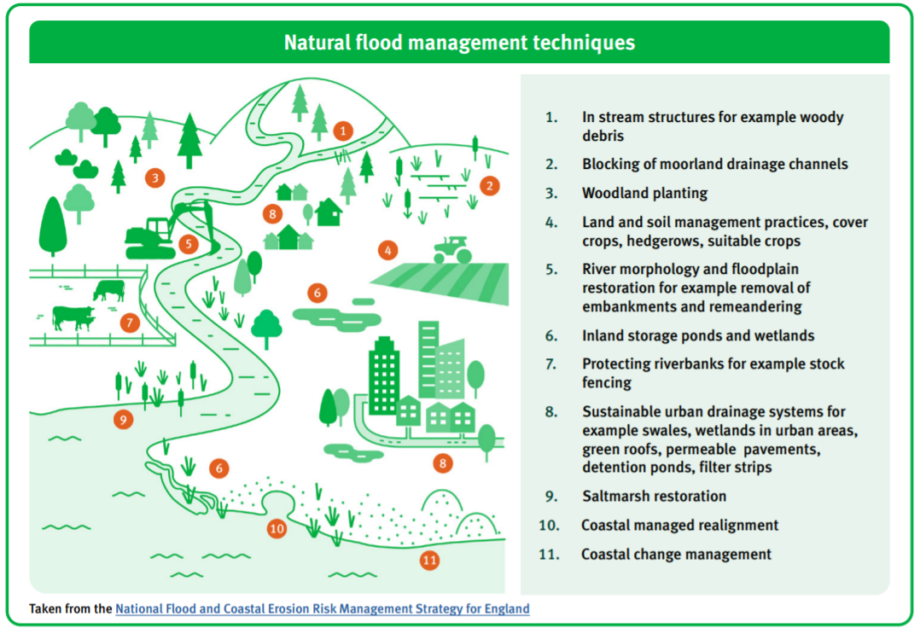
Image taken from the National Flood and Coastal Erosion Risk Management Strategy for England showing the different Natural Flood Management Techniques.
Explore the following NFM resources, pages and toolkits for more information and guidance on natural flood management techniques:
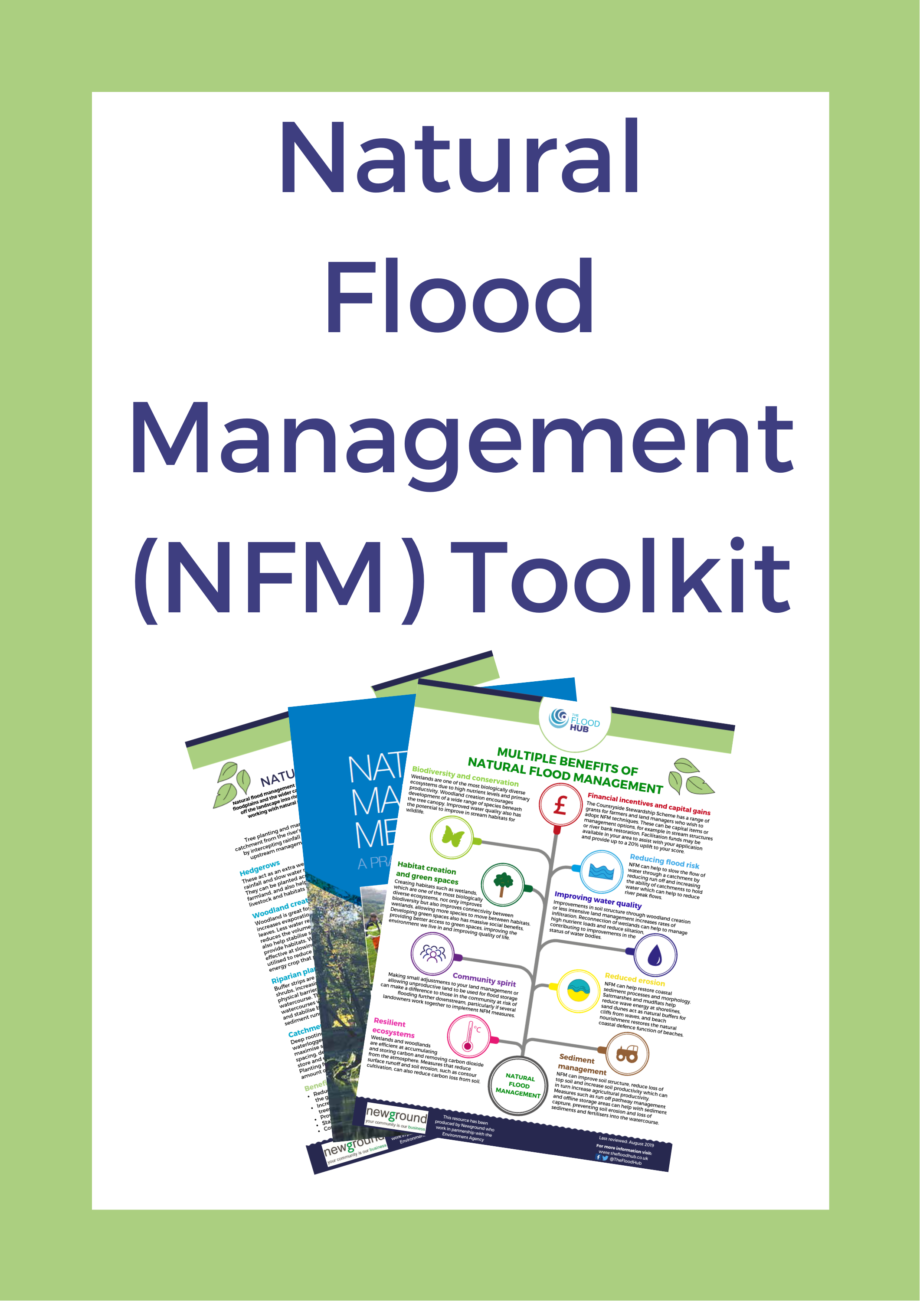
All the resources of the different natural flood management techniques featured on this page can be found in our Natural Flood Management Toolkit which can be found by clicking here.
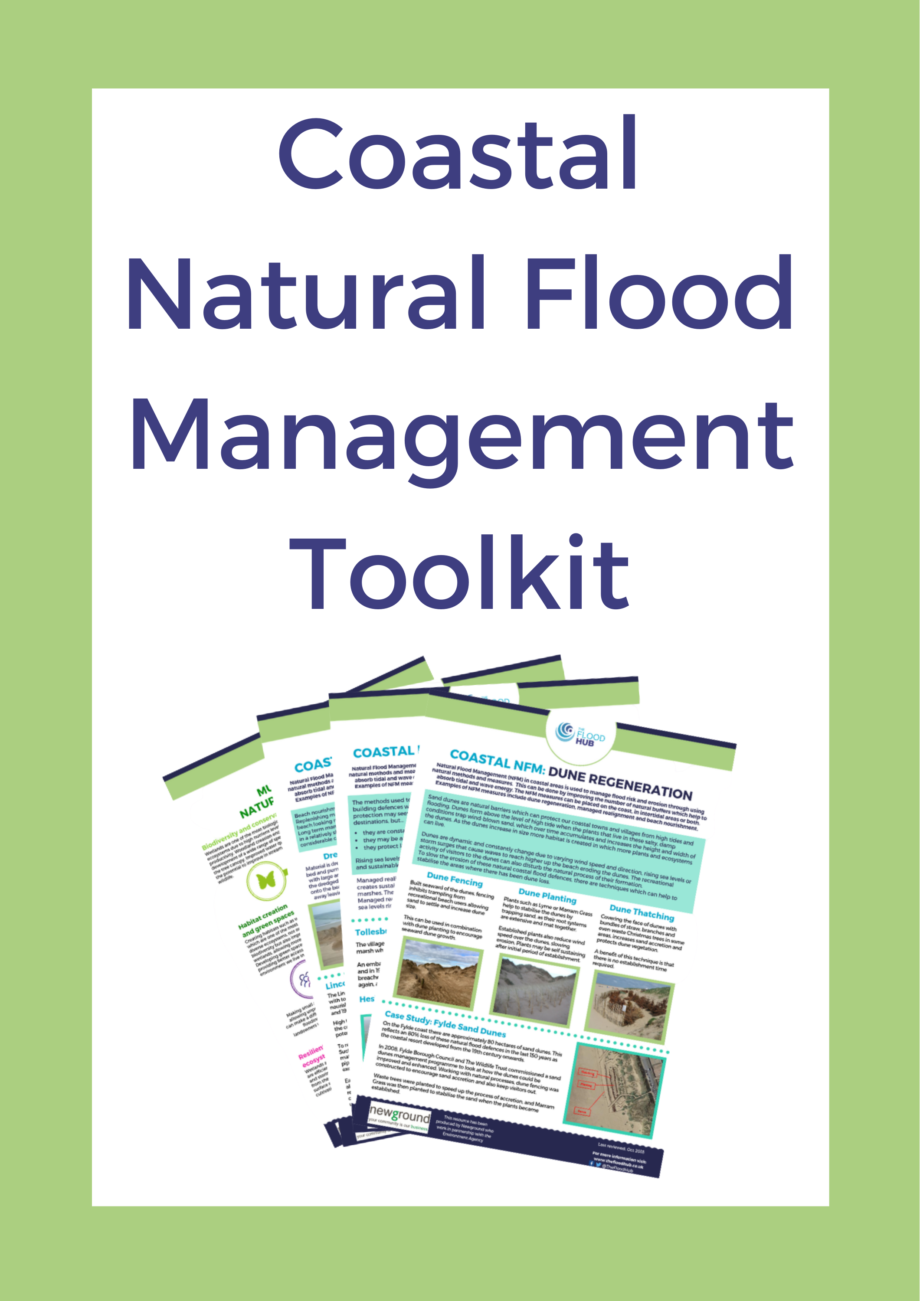
The Coastal Natural Flood Management Toolkit can be found by clicking here.
This involves restoring river channels to a more natural route, to slow the flow of water, allowing rivers to reconnect to floodplains and increase upstream floodwater storage. Many rivers have been altered by straightening or constructing embankments for agriculture purposes and in urban infrastructure. As a result, these alterations prevent the river from flooding the adjacent land (the floodplain) and instead flows quickly downstream, thereby increasing flood risks to communities. River and floodplain restoration involves removing barriers like levees or embankments and creating ponds or wetlands to give the water a designated place to go which reduces flood risk downstream.
There are many benefits to river and floodplain restorations, these include:
Download the resource for more information here.
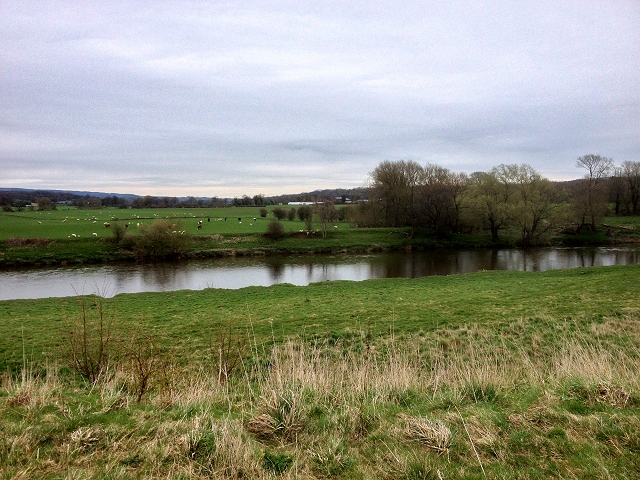
Ribble Valley Flood Plain from the Viewpoint at Brockholes Nature Reserve cc-by-sa/2.0 – © David Dixon – geograph.org.uk/p/4434870
Structures made with natural materials, such as leaky woody dams and boulders, can effectively control water levels, regulate flow, and direct water from a stream to floodplains or storage areas during periods of heavy rain. These structures reduce maximum flood peaks by increasing the amount of time it takes for rainwater to flow downstream. They can also help to collect debris to prevent blockages further downstream at pinch points.
They are often designed to replicate naturally fallen trees and creating different habitats and flow conditions.
There are many benefits of installing leaky woody dams, such as:
Download the resource for more information here.
Tree planting and woodland creation reduces flood risk by absorbing rainwater through their extensive root systems, increasing soil infiltration rates, stabilising slopes to prevent erosion and regulating streamflow by intercepting rainfall. These combined effects help slow down the flow of water, reduce surface runoff, recharge groundwater and mitigate the volume and speed of floodwaters, lowering the risk of flooding downstream.
The benefits of tree planting are more long-term but can:
Download the resource for more information here.
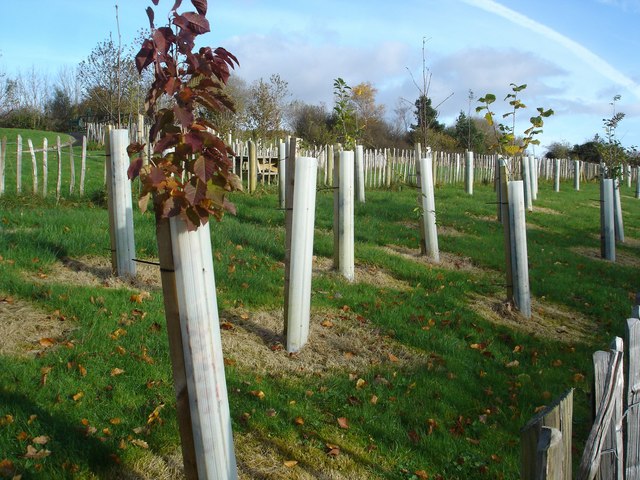
New tree planting at Ervey wood – cc-by-sa/2.0 – © Kay Atherton – geograph.org.uk/p/610815
FACT: Trees can reduce the amount of water reaching the ground by 24-45% for conifers and 10-25% for broadleaves. – Natural Flood Management Measures: A practical guide for farmers.
Many UK moorlands have been heavily eroded due to pollution, over grazing by livestock and draining land for agriculture. Bare and heavily eroded peat on moorlands can be stabilised by planting heather brash, grasses and sphagnum moss, all of which are effective for peat formation. This can help reduce the amount of CO2 in the atmosphere. Gully and grip blocking (obstructing or filling in channels or depressions in the land), also slows the flow of water and raises the water table.
Restored moorlands absorb and hold more rainfall (healthy peat can store up to 20 times its weight in water), slowing down the release of water into rivers. This reduces the peak flow of floodwaters downstream, lowering the risk of flooding. Restored moorlands also promote vegetation growth, which helps prevent erosion and improves the ecosystem’s resilience to heavy rainfall.
The benefits of moorland restoration include:
Download the resource for more information here.
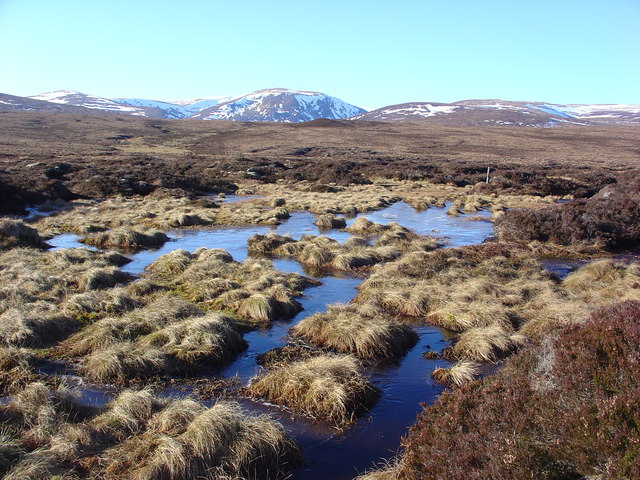
Wet Peatland – cc-by-sa/2.0 – © Alasdair MacDonald – geograph.org.uk/p/688639
This technique involves growing and harvesting willow to increase infiltration and evaporation, thereby reducing the volume of flood water reaching the ground and entering watercourses. Willow serves as an energy crop that is harvested every three years which can also generate income for farmers.
This natural flood management technique can have many benefits:
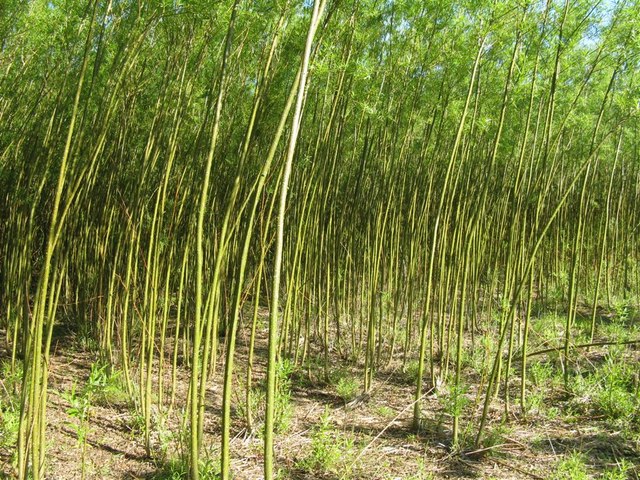
Willow Plantation – cc-by-sa/2.0 – © M J Richardson – geograph.org.uk/p/1888315
The storage of floodwater upstream can alleviate flooding further downstream by reducing water flow along the watercourse. An outlet structure can be used to temporarily hold floodwater during high river levels and return it back to the river once the flood peak has passed. Examples of flood storage areas include constructed wetlands, detention ponds and reservoirs.
There are two types of flood storage; online storage and offline storage: Online storage is the temporary storage of water within the river channel and its floodplain, whereas offline storage is when water within the channel is diverted using an intake structure and held in a separate storage area situated on the floodplain.
Benefits of flood storage include:
Download the resource for more information here
Agricultural land management can enhance upstream management by using techniques that increase the land’s capacity to store water. The main aim is to reduce soil compaction and improve soil quality, enabling it to retain more water and reduce runoff into watercourses.
Techniques which reduce soil compaction include machinery practices, such as minimising loads and using flexible tyres on weak or saturated soils. Runoff control, such as contour cultivation across fields instead of up and down, reduces surface water runoff. These measures help manage the impact of flood events and reduce future flood risk.
The benefits of agricultural land management include:
Download the resource for more information here.
FACT: Runoff from compacted soils is 50-60% higher than on aerated healthy soils. (Agriculture and Horticulture Development Board, 2016) – Natural Flood Management: A Practical Guide for Farmers
Land managers should be aware of soil management rules that they need to follow. Find out more about these rules here.
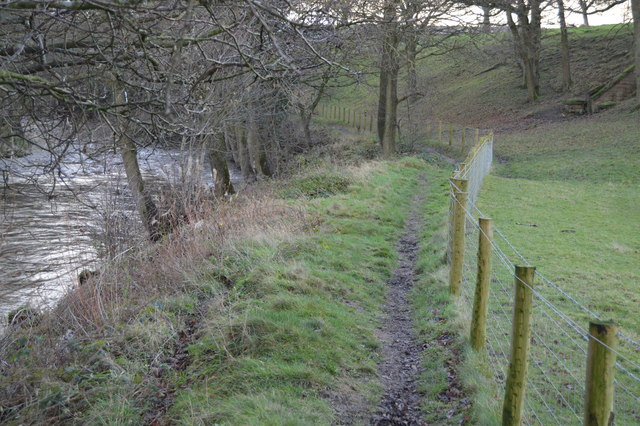
Nidderdale Way along the River Nidd – cc-by-sa/2.0 – © N Chadwick – geograph.org.uk/p/4892169
Coastal schemes are often large scale and use expensive hard engineering methods to help manage coastal flooding and erosion. In contrast, coastal NFM uses natural materials and methods to reduce wave energy and the risk of coastal flooding and erosion. Further details about various types of coastal NFM can be found below.
For completed projects along the North West coastline, our ‘North West Coastline’ page showcases both hard engineered schemes and those implementing natural flood management measures. You can find additional information about these initiatives by following the provided links.
The Online Marine Registry (OMReg) website includes a map of coastal projects happening in the UK and across the world. Various shoreline schemes are displayed on the map and in the database, including coastal NFM schemes involving techniques such as managed realignment and shoreline restoration. Click here to explore the OMREG website.
Sand dunes along coastlines provide a natural defence against coastal erosion and flooding. During storms, waves crash against sand dunes and slowly erode them, as opposed to eroding the coastline or flooding communities behind them. The sand that is lost through erosion is replaced by windblown sediment, but sometimes the dunes erode faster than the rate which wind replaces the lost sand. Therefore, it is important to use effective NFM techniques to protect and maintain the sand dune’s ability to protect the coastline.
The three main techniques to help protect the dunes, trap sediment, and prevent excess erosion are: fencing, planting and thatching.
Dune fencing involves the construction of fences along the seaward face of the dune to reduce wind speed on the surface and encourage deposition of transported sediment.
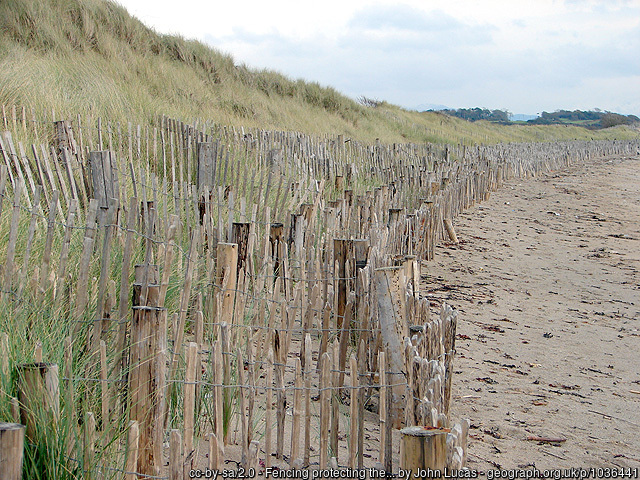
Fencing protecting the dunes and dune grass on the beach near Abererch cc-by-sa/2.0 – © John Lucas – geograph.org.uk/p/1036441
Dune planting is the process of adding vegetation to sand dunes.

Dunes behind Sandham cc-by-sa/2.0 – © Derek Harper – geograph.org.uk/p/6367416
Dune thatching is a technique that involves placing organic materials such as straw or reed bundles on the surface of sand dunes to encourage the accumulation of additional sediment.
Pine trees can be used to restore sand dunes without an environmental permit if certain conditions are complied with. Read the case study on the Fylde sand dunes restoration project here.
Benefits of dune regeneration include:
Download the resource for more information here.
Beach nourishment involves replenishing and restoring beaches eroded by the sea or wind, by adding sand or compatible materials. Methods include dredging, reprofiling and the transportation of material quarried from an area inshore. The extra sand acts as a buffer, absorbing wave energy and protects coastal communities during storms. The nourished beach also helps reduce the effects of storm surges and stabilises the shoreline, making it less prone to erosion. Beach nourishment increases the beaches storage capacity, reducing the risk of flooding in coastal communities as well as maintaining the natural appearance of the beach.
Benefits of beach nourishment include:
It’s important to note that these benefits may only be temporary since the added material can erode over time and may require repeated replenishment.
Download the resource for more information here.
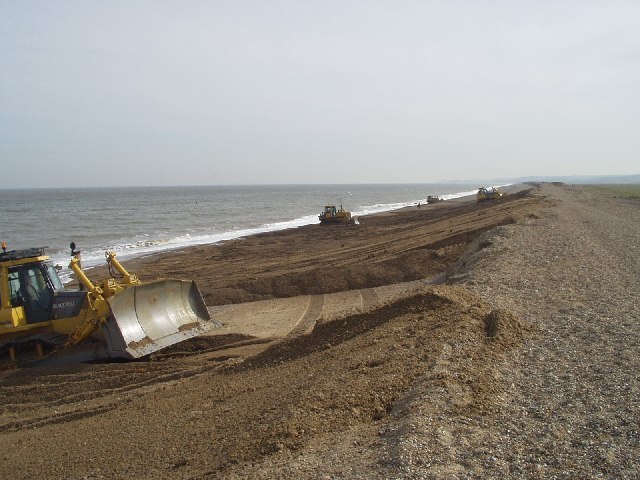
The Beach at Cley, Norfolk – cc-by-sa/2.0 – © Peter Home – geograph.org.uk/p/24206
Managed realignment, also known as coastal realignment or managed retreat, involves the planned breach or relocation of sea defences, deliberately allowing the shoreline to move further inland. This creates sustainable, environmentally beneficial intertidal habitats, such as salt marshes or mud flats.
An example of managed realignment is Fairborne in Gwynedd, Wales, where Gwynedd Council has decided it can no longer defend the homes from rising sea levels. Within a 26 year period – or earlier if forecasts worsen or a storm breaches the sea defences, Fairborne will become the first community in the UK to be decommissioned as a result of climate change.
Benefits of managed realignment include:
Download resource for more information here.
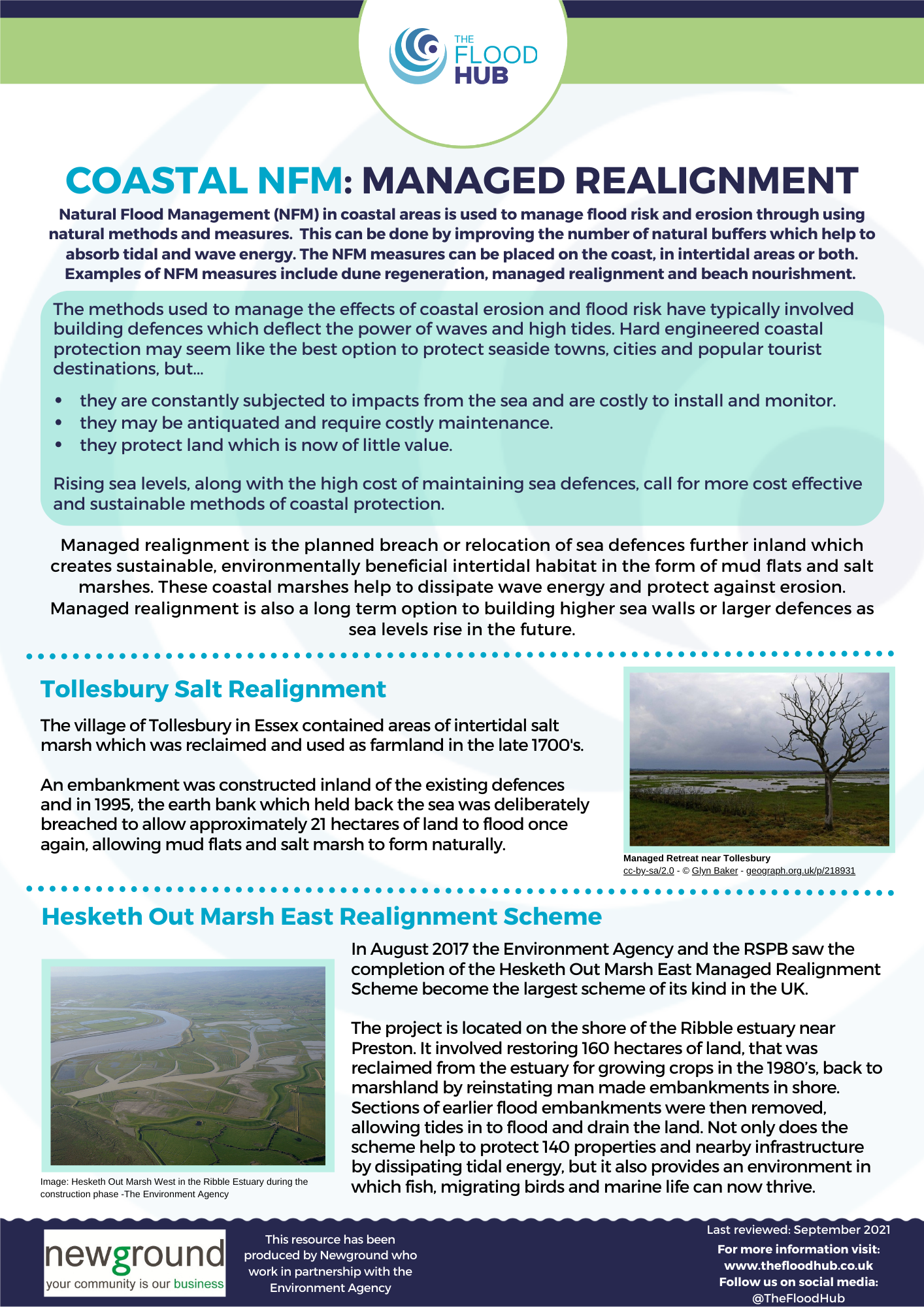
In addition to managing and reducing flood risk, there are various other advantages to using NFM techniques in a catchment. They provide a range of benefits to people and the environment, from providing public amenities to increasing biodiversity.
Click here to download this ‘Multiple benefits of Natural Flood Management’ resource.
NFM measures can help to slow the flow of water through a catchment by reducing runoff and increasing the ability of catchments to hold water which can help to reduce river peak flows. In addition, they can help restore coastal sediment processes and morphology. Saltmarshes and mudflats help reduce wave energy at shorelines, sand dunes act as natural buffers for cliffs from waves, and beach nourishment restores the natural coastal defence function of beaches.
By implementing NFM measures and working together, landowners can effectively manage flood risk in their communities, benefiting those at risk downstream. These measures can also enhance green spaces, offering the opportunity for recreational activities to take place, such as walking and mountain biking, which can improve health and well-being. NFM counteracts the loss of green spaces in urban areas and improves quality of life by providing safe and aesthetically pleasing environments.
There is also the opportunity for some measures such as wetland creation and river restoration to be used as tools for education, recreation and tourism. All these benefits can increase the availability of jobs.
By implementing NFM techniques on your land, you can gain financial benefits through programmes like the Countryside Stewardship scheme. This scheme offers grants for land managers to adopt capital items or management options such as instream structures or riverbank restoration. In addition, facilitation funds may also be available in your area to support your application, offering a 10-20% uplift to your score. For more information about the financial incentives and funding available, visit our Landowner page here.
Most NFM techniques have additional benefits for flora and fauna. Creating wetlands, which are one of the most biologically diverse ecosystems, not only increases biodiversity but can also improve the connectivity between multiple wetland habitats, facilitating the movement of plants and animals. Restoring rivers improves fish habitats and creating woodland provides a habitat for wildlife.
By creating woodland and adopting less intensive soil management techniques, the structure of soil is enhanced, leading to increased infiltration and reduced runoff. This improvement in soil structure contributes to decreased siltation and a reduction of sediment entering rivers and watercourses. As a result, the quality of rivers, lakes and other bodies of water is enhanced in accordance with the Water Framework Directive (WFD).
Offline storage areas play a crucial role in capturing sediment and preventing its loss into watercourses. Creating woodland and managing soil less intensively reduces topsoil erosion and improves soil structure, which can also reduce the amount of sediment entering watercourses. Other methods that can reduce sediment loss are blocking drainage channels so sediment is retained in the land and reconnecting wetlands which can manage high nutrient loads and reduce siltation downstream.
The creation of woodlands and wetlands (e.g. peatland, floodplains and salt marshes) can help the ecosystem become more resilient to the effects of climate change. These types of land are efficient at carbon sequestration which results in the removal of carbon dioxide from the atmosphere, such as via sphagnum moss in peatland. Agricultural land management techniques such as contour cultivation reduces surface water runoff and soil erosion and helps to reduce the loss of carbon from soil.
NFM techniques can reduce erosion at the coast and inland at rivers and ordinary watercourses. Salt marshes and mudflats help to reduce wave energy at shorelines and sand dunes act as a natural buffer for cliffs from waves, reducing the rate of erosion. Beach nourishment restores the natural coastal defence function and sediment processes of beaches. Erosion of riverbanks and other watercourses is reduced via measures such as planting buffer strips on the banks which increases soil stability.
Click on the links below to download the Natural Flood Management (NFM) case studies which showcase great examples of how NFM can help reduce flood risk and provide multiple benefits across the North West.
Wetlands are a sustainable solution to managing flood risk as they are able to slow and store surface run-off following heavy rainfall. The variety of vegetation found in wetland areas create obstacles which intercept rainfall, and a suitable ground which rainwater can infiltrate, both of which slow the flow of water down catchment. Wetlands also create ecosystems which are effective at filtering and cleaning wastewater. This in turn, improves the quality of water, making them an effective approach used by United Utilities when treating wastewater.
Ensuring the effective management of woodlands can increase the effect they have on flood risk and water quality. Woodlands act like a sink which soaks up large volumes of water infiltrating into the ground, and therefore reducing the amount of surface water run-off. The large canopies found in woodlands are able to intercept rainfall as it’s falling, and due to the uneven ground in woodland which is caused by vegetation, shrubs and tree roots, the flow of water is slowed. This has a positive effect by increasing the lag time seen between peak rainfall and peak flow in rivers further down the course.
Peatlands are valuable ecosystems which when healthy, are home to a wide range of species from insects to birds of prey. They can store vast amounts of carbon, and due to their water-storing capacity, they are able to reduce flood risk further down the catchment. United Utilities are working to return the peatlands to their natural state which will create a sustainable flood risk management approach. Peatlands are effective at slowing the flow of water and increasing the time between peak rainfall and peak run-off due to the dense vegetation, such as sphagnum moss.
Cumbria Wildlife Trust Slow The Flow film series –
Watch these four short films, produced by the Environment Agency, explaining how we can slow the flow and help defend our communities from flood water.
Farmland – a natural solution to climate change.
Peatland – a natural solution to climate change.
Floodplains – a natural solution to climate change.
Rivers – a natural solution to climate change.
Natural Flood Management Options – Cumbria Woodlands
Natural Flood Management and Ecology – Cumbria Wooodlands
Centre of Expertise for Water (CERW) Report – Communities at Risk of Flooding and their Attitudes towards Natural Flood Management (NFM)